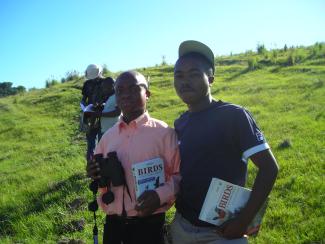Community-based tourism
Off the beaten track
 Krinninger
Young bird-watching tour guides.
Krinninger
Young bird-watching tour guides.
Why is tourism considered a development option in Cata?
Cata is nestled in a scenic and beautiful valley, surrounded on three sides by mountains. They are covered in pristine indigenous forests with a teeming birdlife. There are rivers with wild trout, waterfalls and dams. We see opportunities which the community can tap into. The tourism initiative dovetails perfectly with the overall development vision. After the end of apartheid, the government paid restitution money to the community because it had been deprived of its land as part of the Ciskei homeland. At the same time, land was redistributed. Cata has invested substantial funds from those payments in developing tourism-related infrastructure such as improved roads, signs, accommodation and trails for hiking, mountain biking and bird watching. Even two mountain chalets were built to accommodate tourists. The destination mainly attracts birders and hiking enthusiasts. To entertain tourists, Cata has developed leisure activities in the primary forests nearby.
Who is involved?
Several non-governmental organisations (NGOs) have cooperated since 2001, assisting skills development and enabling community members to manage tourism attractions. The overall aim is to alleviate poverty, to increase income-generating opportunities and eventually to promote sustainable livelihoods. Community members were involved in the design, for instance in mapping, building and maintaining trails. Some villagers, mostly young adults, were trained in birding, guiding and fly fishing. A tourism association was established to assist those who want to improve their tourism-related businesses.
Who are the beneficiaries?
The village community has joined in a formally registered Communal Property Association, which owns the land. This legal institution was introduced after apartheid, designed to benefit communities. In the long term, it would be good if the entire community benefited from the tourism venture. But in the case of Cata, the venture first targeted some specific groups: those community members who accommodate tourists in the chalets or in families’ homes as well as those who work as guides. However, the tourism initiative also aims to add value to the community as a whole. It is expected to trigger economic and skills development in general. Moreover, small farmers benefit because they grow food that is served to the tourists.
What has been achieved so far?
The community has established a project steering committee. It has the mandate to manage day-to-day tasks in cooperation with a profit-oriented tourism association made up of community members. The tourism association has adopted a marketing plan, designed a brochure and hosts a website for booking and information. It has trained community members in management skills. Young adults have been certified as fully-fledged tour guides, including certificates for fly fishing and birding. Apart from hiking, birding, fishing, horse riding and so on, Cata now has a heritage trail and a small museum. In terms of outreach, Cata tourism networks with local and regional authorities and the famous tourism hamlet of Hogsback nearby.
What is the impact on poverty?
The tourism related infrastructure that has been developed has created sustained, but limited income for households. Some young adults have used the skills acquired through the tourism venture to secure employment outside Cata and therefore improve their household income.
Is Cata tourism sustainable in the sense of being able to cope without external support?
There is great potential, but like any business venture it requires sustained, consistent and concerted efforts. Cata is off the beaten track of the Wild Coast route, which is very popular with younger travellers who enjoy the outdoors and who support responsible tourism. In order to attract more tourists, Cata must be marketed. Operating capital is needed, but lacking. Cata is quite popular with overseas visitors and people who work in the development sector. They appreciate what Cata has to offer and support community-based initiatives. But Cata needs to attract more visitors from other sectors of South African society.
Why is that a challenge?
It takes time to develop schemes and empower people. There is no quick fix. One-off marketing events have only limited impact. Most projects of this nature struggle once external donor funding ends. In Cata, for instance, there will be no operational funding to pay for the tourism association to network with other institutions. So far, such work has been paid by international and South African donors. Doing business costs money. When they start, most community-based enterprises really struggle to generate enough revenues to pay their staff. Their scope for marketing and networking is very limited.
Is a village community able to manage business ventures collectively?
Yes, it is, but there are challenges. In Cata, for example, many youth feel stifled by older members of the community. The elders are traditionally the ones who take decisions. Community structures often stifle debate, dissent and innovative ideas. Some of those ideas would be useful, of course.
Does that apply to the wider context of rural communities in the Eastern Cape?
Yes, very much so. For instance, the reality is that most young community members escape their rural roots and look for work in the cities. That is where most employment opportunities are. There is just not enough of a viable local economy to make them stay in rural villages, no matter how much they love their rural homes. This is a persistent feature throughout the Eastern Cape – if not most of South Africa. And that is precisely why it would be good to make a difference with tourism.
Fuzile Zetu is community development manager at RULiv (Promoting Rural & Urban Livelihoods), a non-profit organisation based in East London, South Africa.
zetu@ruliv.org.za
Links:
Cata tourism:
http://www.cata.org.za
Bird watching in Cata:
http://birdingroutes.co.za/sites/birding-sites2.html?site=ECBR-BS-CATA

